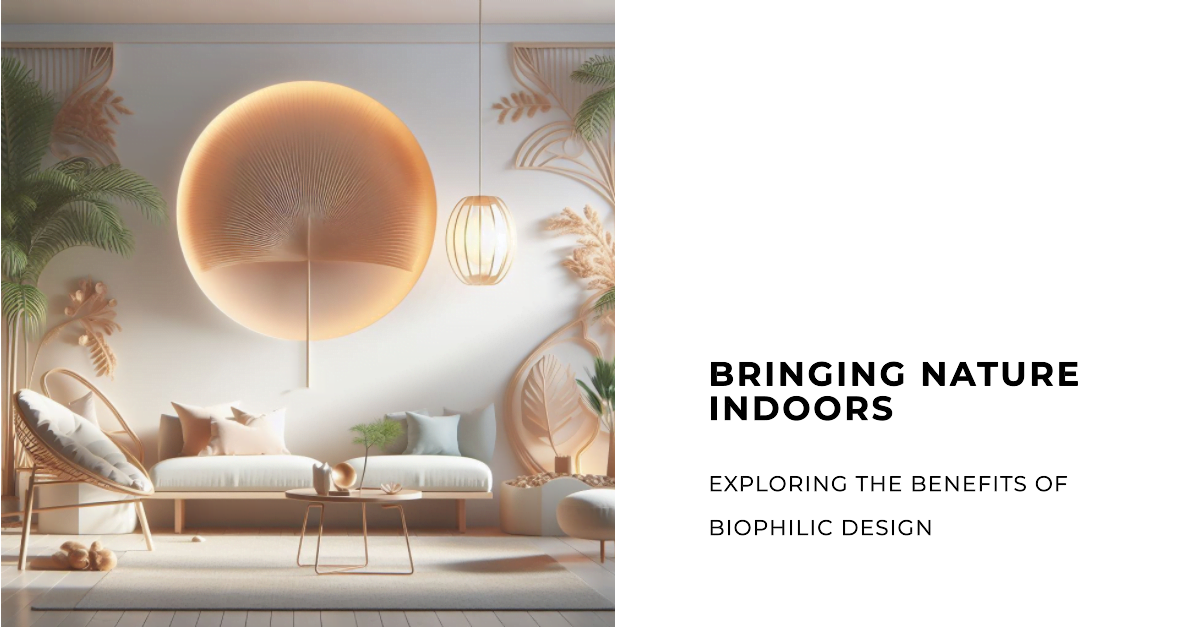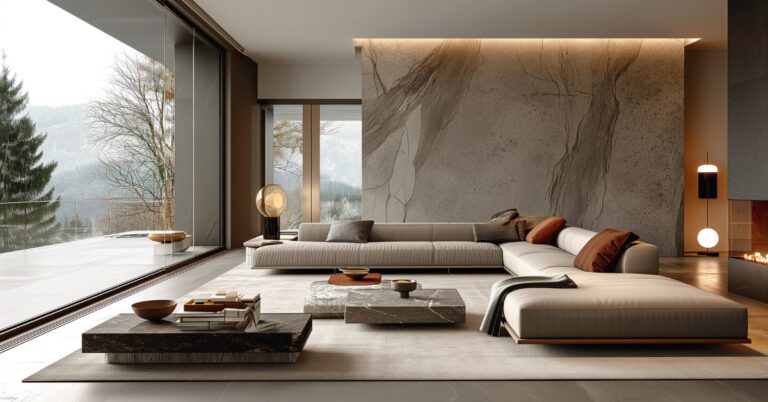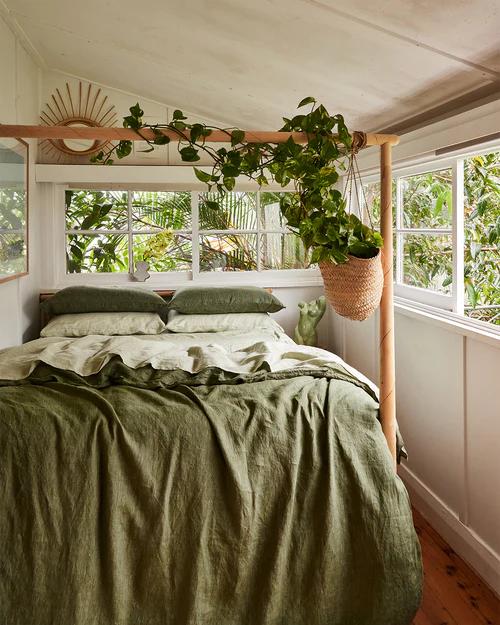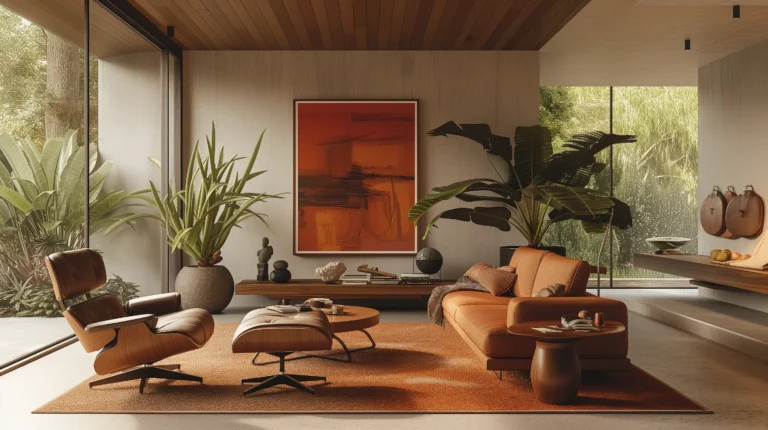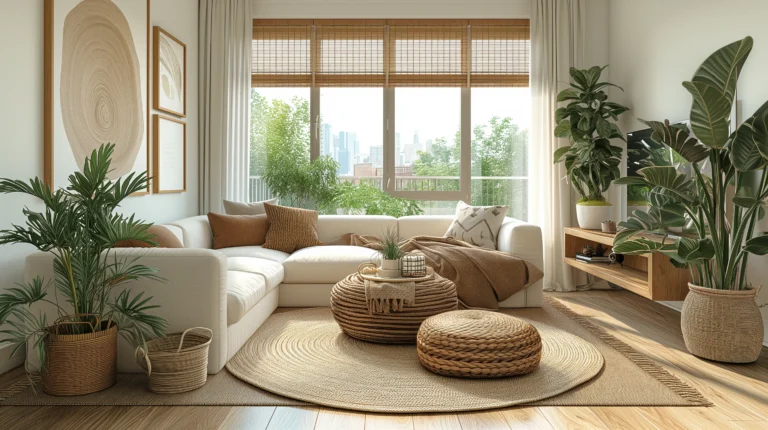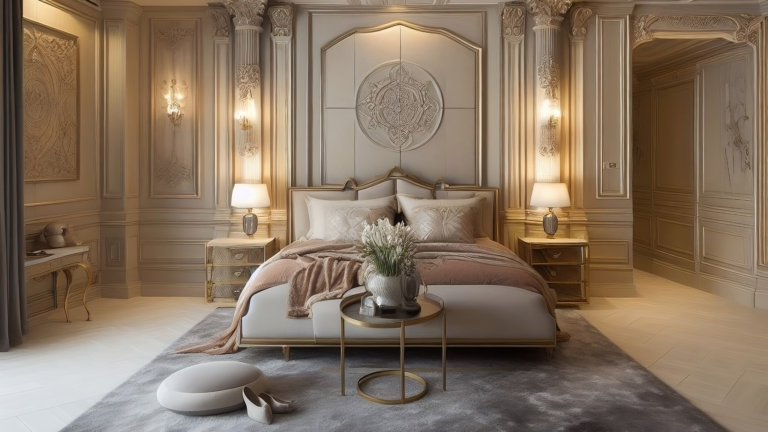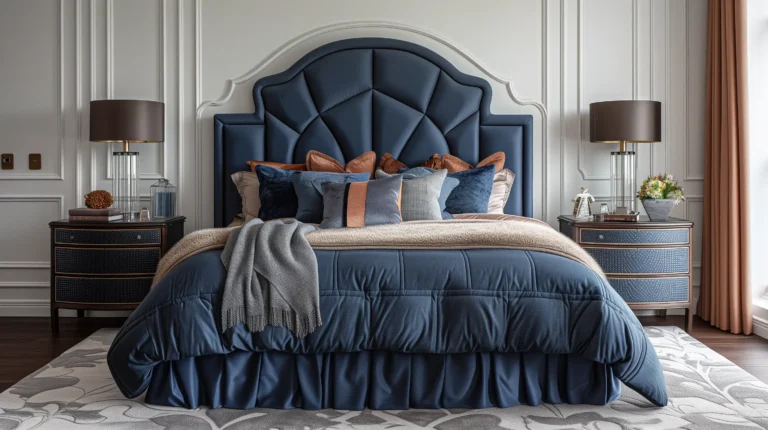In this article, we will look at how to incorporate biophilic design into your home. We have included a table of contents for your convenience if you would like to skip sections.
Definition of Biophilic Design and Its Importance
What exactly does Biophilic design mean? Biophilic design is more than just a trend; it’s a philosophy that integrates nature into the built environment.
Imagine walking into a room and feeling like you’re in a serene forest or a tranquil beach. That’s the magic of biophilic design. It’s not just about adding a potted plant here and there; it’s about creating spaces that foster a deep human-nature connection. Why is this important? Because it taps into our innate love for nature, promotes sustainability, and enhances our overall well-being.
Brief History of Biophilic Design
Though the term may sound modern, the concept has ancient roots. Think of the Hanging Gardens of Babylon or the Roman atriums filled with greenery. Over the years, as urban landscapes expanded and green spaces dwindled, the need for a human-nature connection in architecture became more pressing. Fast forward to today, and biophilic design is a cornerstone of sustainable architecture, making our spaces greener, both literally and metaphorically.
Overview of the Benefits of Biophilic Design
The perks? Oh, where to start! From boosting mental health to reducing stress, improving air quality, and even enhancing productivity, biophilic design is a win-win for both people and the planet. It’s not just about aesthetics; it’s about creating environments that make us feel good and do good. Whether it’s through energy-efficient materials or water management systems, the benefits are far-reaching and holistic.
Biophilic Design Elements
Nature-Inspired Patterns and Textures
Picture this: a wall adorned with patterns that mimic the intricate veins of a leaf or the swirling shapes of a seashell. These nature-inspired patterns and textures aren’t just eye candy; they evoke a sense of calm and connection to the natural world.
Natural Light
Ah, the sun! Nothing beats the feeling of natural light streaming through your windows. It’s not just about brightening up the room; natural light regulates our body clock, boosts our mood, and even enhances productivity.
Views of Nature
Imagine working at your desk and glancing out to see a lush garden or a serene water feature. Views of nature are more than just a pretty sight; they’re a daily reminder of the beauty that exists outside our four walls.
Water Features
The sound of trickling water can transform a space. Whether it’s a small indoor fountain or a grand outdoor waterfall, water features add a dynamic, calming element to any environment.
Indoor Plants
Who doesn’t love a good houseplant? But it’s not just about the aesthetics. Indoor plants purify the air, reduce stress, and can even improve focus.
Living Walls
Take your love for plants to the next level with a living wall—a vertical garden that’s literally a breath of fresh air. It’s like having a piece of the forest right in your living room.
Natural Materials
Wood, stone, bamboo—using natural materials isn’t just a design choice; it’s a nod to sustainability and a step towards reducing our carbon footprint.
Colors Inspired by Nature
Earthy tones, ocean blues, forest greens—colors inspired by nature have a way of making a space feel more grounded and tranquil.
Natural Shapes and Forms
It’s not just about straight lines and sharp angles. Incorporating natural shapes and forms like curves and organic patterns adds a touch of whimsy and complexity to a space.
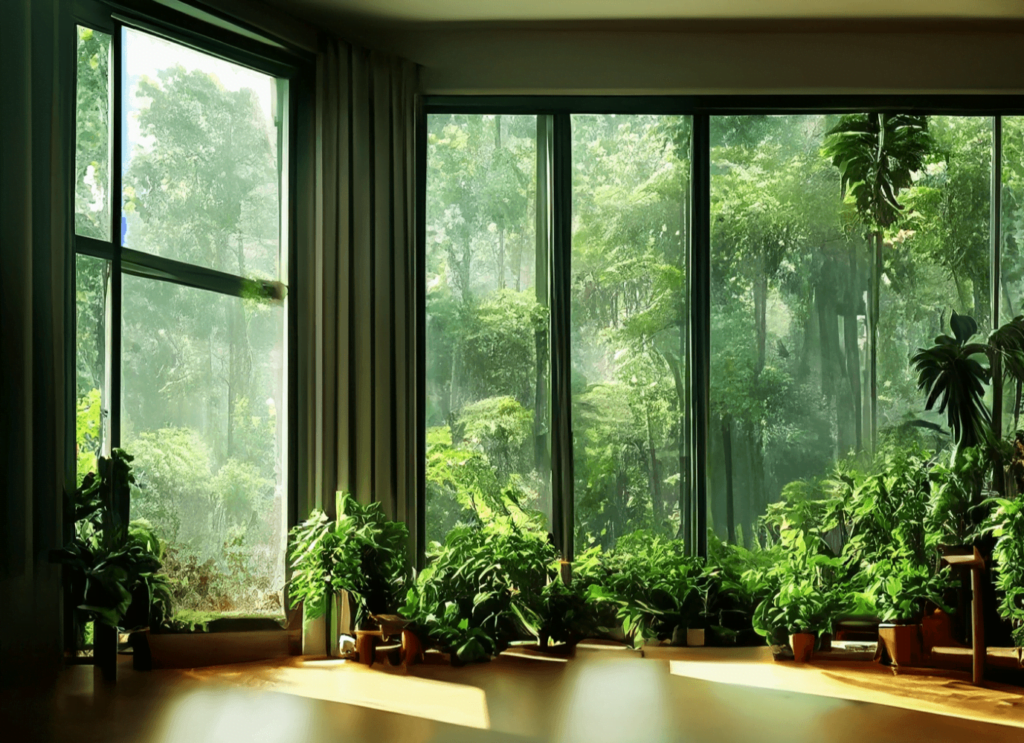
Biophilic Design Applications
Interior Design
Step inside a biophilically designed home, and you’ll feel it—a sense of peace, a breath of fresh air. It’s not just about potted plants and wooden furniture; it’s about creating a space that nurtures your soul. Think living walls in the living room, natural light flooding the kitchen, and nature-inspired textures in the bedroom.
Exterior Design
The exterior of a building can be just as inviting as the interior. Picture green rooftops, vertical gardens, and water features that not only beautify the space but also contribute to sustainability. It’s architecture that coexists harmoniously with nature.
Urban Planning
Biophilic design isn’t confined to individual buildings; it’s transforming entire cities. Imagine urban landscapes with more parks, green corridors, and even “bird-friendly” buildings. It’s about making room for nature in the concrete jungle.
Biomimicry
Ever heard of buildings that “breathe” or materials that mimic the resilience of spider webs? That’s biomimicry design inspired by nature’s own engineering marvels. It’s innovation at its finest, solving human problems by looking to the natural world.
Ecosystems
Biophilic design goes beyond aesthetics; it’s about creating ecosystems. Whether it’s a rainwater harvesting system or a garden that attracts pollinators, it’s design that benefits both humans and the environment.
Biodiversity
Incorporating a variety of plants, using materials that don’t harm wildlife, and creating spaces that allow for animal habitats. Biophilic design celebrates biodiversity, making our built environment a haven for different species.
Climate Change
Yes, biophilic design has a role to play in combating climate change. Through energy-efficient materials and sustainable practices, it’s a step towards a greener, more resilient future.
Energy Efficiency
From solar panels to energy-saving lighting, biophilic design is as practical as it is beautiful. It’s about creating spaces that not only look good but also reduce our energy consumption.
Air Quality
Plants that purify the air, ventilation systems that mimic natural airflow—biophilic design is a breath of fresh air, quite literally.
Water Management
Think sustainable drainage systems and water features that recycle water. It’s a design that’s as mindful of water conservation as it is of aesthetics.
Acoustics
The sound of rustling leaves, the trickle of water—biophilic design considers acoustics, creating spaces that not only look good but also sound good.
Lighting
Natural light is the star, but even artificial lighting in biophilic design mimics the natural rhythms of daylight, enhancing mood and well-being.
Materials
Sustainable, recyclable, and natural—when it comes to materials, biophilic design opts for options that are as good for the planet as they are for us.
Benefits of Biophilic Design
Improved Health and Well-Being
Ever noticed how a walk in the park can lift your spirits? Biophilic design brings that feel-good factor right into your living space or workspace. It’s not just about looking pretty; it’s about enhancing your physical and emotional well-being.
Biophilic Design and Mental Health
Stress, anxiety, and depression—modern life comes with its share of mental health challenges. Biophilic design acts like a natural antidote, creating spaces that calm the mind and soothe the soul.
Biophilic Design and Physical Health
Cleaner air, better lighting, and less noise—biophilic design isn’t just a feast for the eyes; it’s a boon for your physical health. It’s like living in a wellness retreat, but you don’t have to pack your bags.
Increased Productivity and Creativity
Feeling stuck or uninspired? A biophilic environment might be just what you need. Natural light, plants, and even colors can boost your creativity and productivity. It’s not just a theory; it’s backed by science.
Biophilic Design and Workplace Productivity
Imagine fewer sick days, more engaged employees, and a workspace that everyone loves. That’s the power of biophilic design in the workplace. It’s not just an aesthetic choice; it’s a smart business move.
Biophilic Design and Creativity
Artists, writers, and designers—creative minds thrive in spaces that inspire. And what’s more inspiring than nature? Biophilic design is like a muse that never leaves your side.
Enhanced Learning and Cognitive Function
Schools and educational spaces are catching on, too. Natural elements in classrooms and libraries can enhance focus, improve retention, and even make learning more enjoyable.
Biophilic Design and Education
From kindergartens to universities, educational institutions are embracing biophilic design. It’s not just about creating beautiful campuses; it’s about fostering environments that enhance learning.
Biophilic Design and Cognitive Function
Sharper focus, better memory, enhanced problem-solving skills—biophilic design has a positive impact on how our brains function. It’s like a workout for your mind, without breaking a sweat.
Reduced Absenteeism and Turnover
Happy employees are loyal employees. Biophilic design can reduce absenteeism and turnover by creating a work environment that people love to be in.
Biophilic Design and Employee Retention
It’s simple—when people love where they work, they’re less likely to leave. Biophilic design is an investment in employee satisfaction and, by extension, in the success of your business.
Lower Energy Costs and Improved Efficiency
Sustainability isn’t just good for the planet; it’s good for your wallet. Biophilic design can significantly reduce energy costs through smart lighting, insulation, and water management.
Biophilic Design and Energy Efficiency
Green is the new gold. Energy-efficient practices in biophilic design not only save you money but also contribute to a more sustainable future.
Improved Air and Water Quality
Clean air and clean water are not luxuries; they’re necessities. Biophilic design prioritizes both, making it a holistic approach to well-being.
Biophilic Design and Indoor Air Quality
Say goodbye to stuffy rooms and hello to spaces that breathe. Plants, ventilation, and materials—all work in harmony to improve indoor air quality.
Biophilic Design and Water Management
From rainwater harvesting to water-efficient fixtures, biophilic design is as mindful of water as it is of aesthetics.
Reduced Noise Levels
The rustle of leaves, the chirping of birds—biophilic design incorporates natural sounds that drown out the noise pollution of our busy lives.
Biophilic Design and Acoustics
It’s not just about what you see; it’s also about what you hear. Acoustic design in biophilic spaces enhances not just the aesthetics but also the ambiance.
Case Studies
Examples of Successful Biophilic Design Projects
From corporate offices to public parks, biophilic design is making waves—and for good reason. Take the Eden Project in the UK, a series of geodesic domes housing thousands of plant species. It’s not just a tourist attraction; it’s a testament to the power of integrating nature into architecture. Or consider Singapore’s Changi Airport, where a massive indoor waterfall and lush gardens make layovers feel like a tropical getaway.
Analysis of the Impact of Biophilic Design on Users
The benefits aren’t just theoretical; they’re measurable. Companies that have embraced biophilic design report higher employee satisfaction, reduced stress levels, and even increased sales. Schools with biophilic elements have noted improved student performance and well-being. It’s not just about creating beautiful spaces; it’s about enhancing the quality of life for those who use them.
Biophilic Design in Different Regions and Cultures
Biophilic design is a global movement that transcends geographical and cultural boundaries. In Japan, the concept of “forest bathing” has inspired biophilic designs that focus on the therapeutic effects of being in nature. In Scandinavian countries, the use of natural materials like wood and stone is not just a design choice; it’s a lifestyle. And in urban centers like New York, rooftop gardens and green walls are turning concrete jungles into livable, breathable spaces.
Future of Biophilic Design
Emerging Trends and Innovations in Biophilic Design
The future is green, and not just the color! Biophilic design is evolving, with new trends and innovations that push the envelope. Think smart gardens that can be controlled via an app, or “living” buildings that adapt to environmental conditions just like a plant would. It’s not science fiction; it’s the next frontier in sustainable design.
Biophilic Design and the Future of Architecture and Urban Planning
As cities grow and the climate crisis intensifies, the role of biophilic design in architecture and urban planning becomes increasingly crucial. We’re talking about entire neighborhoods designed with nature in mind, from tree-lined streets to community gardens and even wildlife corridors for urban fauna. It’s a holistic approach that considers not just human well-being but the health of the planet as well.
The future of biophilic design is not just promising; it’s essential. As we face unprecedented environmental challenges, integrating nature into our built environment is not just a luxury; it’s a necessity. And the best part? It’s a future we can all be a part of, one sustainable choice at a time.
Conclusion
Recap of the Benefits and Applications of Biophilic Design
From boosting mental well-being to fostering sustainability, biophilic design is a multifaceted approach that enriches our lives in countless ways. It’s not just a design trend; it’s a lifestyle, a philosophy, and a critical tool for building a more sustainable future. Whether it’s in our homes, workplaces, or public spaces, the applications are as diverse as the benefits are profound.
Call to Action for More Widespread Adoption of Biophilic Design Principles
So, what’s stopping us from embracing this transformative design philosophy? It’s time to move beyond admiration to action. Whether you’re an architect, a homeowner, or simply someone who appreciates the beauty of nature, you have a role to play. Advocate for more green spaces in your community, opt for sustainable materials in your next renovation, or simply add a few more plants to your living space. Every little bit counts.
Final Thoughts on the Importance of Biophilic Design for Human and Environmental Well-Being
In a world where stress is the norm and environmental crises are escalating, biophilic design offers a beacon of hope. It’s a reminder that we are intrinsically connected to nature and that by nurturing this connection, we can improve not just our own well-being but that of the planet as well.

